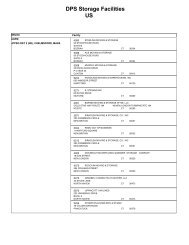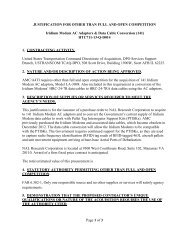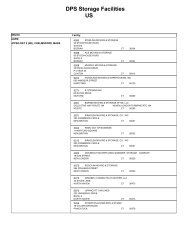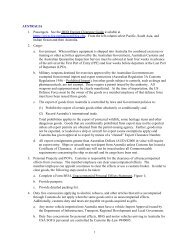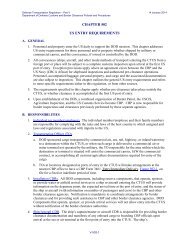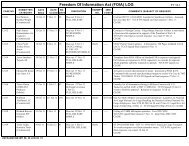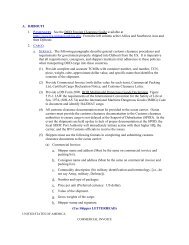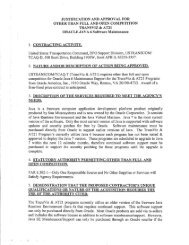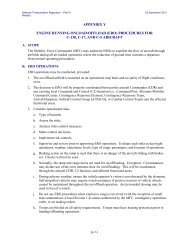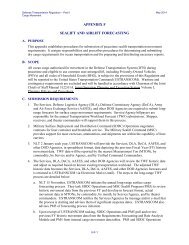A HISTORICAL OVERVIEW OF THE NATION’S COURIERSOne of the earliest recorded, and most well known, occasions where a messenger relayed informationof national importance occurred in 490 B.C. following the defeat of an invading Persian Army by theAthenians. The retreating Persians, re-embarked on their ships, headed for Athens to attack the undefendedcity. Phidippides, a fast-footed warrior, was called upon to run the 26 miles to the city towarn the citizens. After fighting all day and a 3-hour run to the city, Phidippides died of exhaustionafter delivering his message.Clearly, the need to safeguard information has existed since the dawn of mankind. As civilization becamemore sophisticated, organized, and social in nature, the need to provide secure transmission ofinformation has become essential to the existence of nations and success of its military and politicalleaders. More recently, the secure movement of classified, sensitive, and often bulky, material hasbecome more complex due to increasing sophistication of the threat.This introductory chapter of the brief history of the Nation’s Couriers will provide a brief, genericoverview of our fifty-year success story. Fifty down, many more to come…Pre-World War IWe have all seen movie and television scenes where a loyal subject was entrusted with vital informationon an enemy or opponent and tasked to deliver it to another party. Such a situation was equallytransferable to ancient warfare; envision the appointed “courier” galloping off into the distance in orderto deliver the important data. Later, during the American Civil War, military observers used hotair balloons to rise over the battle lines to spy on the enemy’s disposition, then signaled the informationto ground forces using mirrors or signal flags. Though somewhat effective, this passage of sensitiveinformation was not done in secret – everyone on the battlefield was witness to the event.During the early part of the century, a small group ofForeign Service Officers was responsible to transportnational information to overseas areas and Americangovernment officials. Unfortunately, this group waslimited in size and capabilities, unable to handle allrequirements to ferry articles between the key ports ofembarkation. Eventually, American ship captains andselected, trustworthy American travelers were used toaugment the Foreign Service officers. Referred to as“Bearers of Dispatches," these individuals were givensealed packages of mail to safeguard and deliver tospecified officials at their destination. However, asour government moved toward active participation inWorld War I, the requirement for a means of securemovement of material grew and grew.Post - World War IClearly, the large-scale secrecy requirements experienced during World War I pointed out the needfor an organized system of transferring sensitive military information between headquarters and officials.In response, a courier service called "The Military Postal Express Service," was established on2 December, 1918. It consisted of 70 Army officers and enlisted personnel, which was divided intotwo parts, the Overseas Service and the European Service. Steady cutbacks followed World War I,leading to the termination of this service at the end of fiscal year 1933. Loud protests and Presiden-PAGE ~ 6
tial backing were instrumental in forcing a reinstatement of the courier service two years later. Butthis rebirth was very inauspicious with only a relative handful of couriers being funded.Prior to World War II, and for a brief period thereafter,War Department classified material was sent throughregistered mail channels and, within the continental<strong>United</strong> <strong>States</strong> (CONUS), by military message centers.Any classified material destined to overseas areas wasentered into the State Department’s Diplomatic CourierService. Under the provisions of an Act of Congress,24 Army officers were detailed to the State Departmentto serve as diplomatic couriers for six months.Prior to the commencement of WWII, the Army usedcouriers for the express purpose of moving material andcommunications between War Department offices andgeneral headquarters of separate theaters of operations,and between the theater headquarters and major tacticalunits within the theater. This service provided securemovement of Top Secret, Secret, and Confidential communications. This need for rapid and reliablecommunications grew as war clouds began to form over Europe and Asia. Interest in a viable courierservice grew accordingly.World War IIOfficers Detailed to the Department ofStateBy War Department Directive G-1/16396-121, 24 December 1941, subject: Constitutionand Activation of the Army Courier Service, the Adjutant General (TAG) of theArmy was directed to activate the Army Courier Service. It was formally activated on9 March 1942 and performed wide-ranging courier missions. Shortly thereafter, effective20 March, the Army Postal Division was established, and charged with administrativesupervision of both the Army Postal Service and Army Courier Service.When activated, the Army Courier Service was comprised only of officer personnel. They providedservice within the continental <strong>United</strong> <strong>States</strong> (CONUS) and between CONUS and Hawaii, Australia,Africa, and the Middle East for important official military communications. This officer courier serviceinitially operated only “on call,” and was used to transmit communications, both classified andunclassified, marked “For Transmission by Hand of Officer Couriers Only,” or to serve addresseeslocated at points other than those served by the Enlisted Courier Service (see below). Couriers traveledprimarily by air and each article was personally escorted to its destination. Later, the list of materialto be moved was expanded.Shortly thereafter, on 2 May, an Enlisted Courier Service, composed of two officers and 52 enlistedmen, was also inaugurated. This organization was tasked to transmit Secret and Confidential matterbetween the War Department and principal Army and other U.S. government agencies located withinWashington, D.C., or in the local vicinity. Initially, a total of 27 organizations was involved, but thisnumber grew to more than 300 activities. The Enlisted Courier Service operated 7 days per week betweenthe hours of 0800 and 2400.Faced with difficulties in securing priority for air travel for couriers, the decision was made aboutthis point in time to establish “courier transfer stations” (CTS) at principal points in CONUS andoverseas theaters. This permitted the selection and “designation” as couriers of officers who alreadyhad travel priorities and were destined for locations to which courier pouches were addressed. ThisPAGE ~ 7
- Page 1 and 2: PAGE ~ 1
- Page 3 and 4: This publication is likely the firs
- Page 5: INTRODUCTIONTherefore, I say: Know
- Page 9 and 10: Establishment of the Armed Forces C
- Page 11 and 12: • Air Force alignment was similar
- Page 13 and 14: coming more beefed up. A year later
- Page 15 and 16: sponsibilities, and similar guidanc
- Page 17 and 18: ase, and was responsible for most o
- Page 19 and 20: The middle of the decade saw U.S. e
- Page 21 and 22: data, and related information. A fu
- Page 23 and 24: The DCS has a normal command and st
- Page 25 and 26: • Resource Management (J8): Respo
- Page 27 and 28: The life of a DCS courier is exciti
- Page 29 and 30: During the last decade, the terms a
- Page 31 and 32: PAGE ~ 31
- Page 33 and 34: Army Courier Service couriers wore
- Page 35 and 36: The Modified Navy Design: Another e
- Page 37 and 38: This emblem has been “modernized
- Page 39 and 40: Incumbent Rank Service Inclusive Da
- Page 41 and 42: intelligence organizations, NSA, CI
- Page 43 and 44: The DCS Training SchoolIn January 1
- Page 45 and 46: they will at their future stations.
- Page 47 and 48: movement could be harnessed to faci
- Page 49 and 50: Though DCS had reached a high of 16
- Page 51 and 52: A SEA OF MUDOn a fateful day in ear
- Page 53 and 54: gravity and gained momentum as it g
- Page 55 and 56: JUST CAUSE/PROMOTE LIBERTYSeveral e
- Page 57 and 58:
A new problem was sometimes encount
- Page 59 and 60:
Anticipating an immediate increase
- Page 61 and 62:
In less than one week, DCS had put
- Page 63 and 64:
A major event which impacted signif
- Page 65 and 66:
• DESERT SPRINT: Desert Sprint mi
- Page 67 and 68:
Eskan Village, 18 miles south of Ri
- Page 69 and 70:
Living in Saudi Arabia was hot, dry
- Page 71 and 72:
SOMALIA - LAND OF TURMOILAn interes
- Page 73 and 74:
jor Faye Williams-Norris, North Ame
- Page 75 and 76:
“DESERT SUN” mission. During th
- Page 77 and 78:
The power went on and off during th
- Page 79 and 80:
22 June, the couriers from Okinawa
- Page 81 and 82:
However, no aircraft could fly into
- Page 83 and 84:
Preparation and DeploymentThe proxi
- Page 85 and 86:
ordinator, for this assistance was
- Page 87 and 88:
A Personal Observation (provided by
- Page 89 and 90:
Now, after the day’s missions wer
- Page 91 and 92:
DESERT SUN & OTHER EXCITING EXCURSI
- Page 93 and 94:
Operation UPHOLD DEMOCRACY began wi
- Page 95 and 96:
for a possible confrontation with I
- Page 97 and 98:
the globe to ensure that all moveme
- Page 99 and 100:
STATION DIGRAPH LOCATION DISPOSITON
- Page 101 and 102:
STATION DIGRAPH LOCATION DISPOSITON
- Page 103 and 104:
STATION DIGRAPH LOCATION DISPOSITON
- Page 105 and 106:
REGIONS SYMBOL DISPOSITIONCONUS/Nor
- Page 107 and 108:
Joint Meritorious Unit Award #11 Ja
- Page 109 and 110:
Joint Meritorious Unit Award #39 Au
- Page 111 and 112:
Joint Meritorious Unit Award #51 Fe
- Page 113 and 114:
WHERE’S THE COURIER…With thanks
- Page 115 and 116:
ARFCOS Manual. The first ARFCOS man
- Page 117 and 118:
Football-size Boxes. In mid-October
- Page 119 and 120:
Slimmed-down Manual. A revised and
- Page 121 and 122:
IN MEMORIAMEarly in 1989, during th
- Page 123 and 124:
PAGE ~ 123



